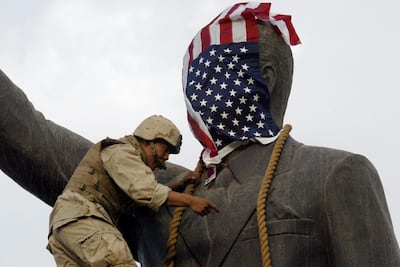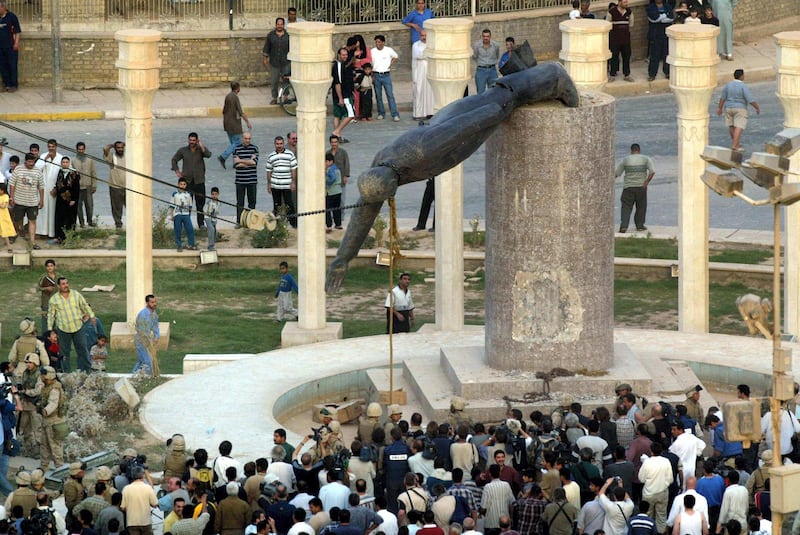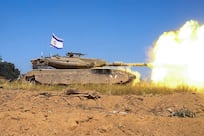Jumaa Serham was behind the counter of his grocery shop when he saw people rushing toward Baghdad's Firdos Square.
Others were in the middle of the action, as American troops surrounded a statue of Saddam Hussein.
Ghilan, then 29, recalls voices screaming for the 30-foot monument, a potent emblem of autocratic rule, to fall.
To get a better view, Osama Mehdi, still a teenager, had for a few moments stood on top of the US military vehicle that would eventually succeed where sledgehammers had failed.
"I remember most of the people just dancing, laughing, saying 'Welcome' to the Americans, and I was one of them," said Ghilan.
The years following the US-led invasion became the most violent in Iraq's modern history. A protracted insurgency targeted occupying forces and an interim Iraqi government. Sectarian infighting, long dormant, was unleashed among militias. Kidnappings and killings became common. Shiite and Sunni divisions deepened.
Extremism, first with Al Qaeda and then ISIL, flourished. Iraqis were brutalised.
_________________
Beyond the Headlines Podcast: Saddam Hussein's downfall, 15 years on
Fifteen years on, Saddam's legacy and the flaws in Iraq's fractured politics
_________________
It was far from the promise of American democracy and rule of law that many anticipated would accompany the fall of Saddam’s statue on April 9, 2003.
"I thought the situation would be better, there would be jobs, the country would be free and democratic. But almost immediately after that day I witnessed too many things that hurt me," said Ghilan.
Firdos Square, now as it was then, is a metaphor for contemporary Iraq.
So politicised is the area, successive groups of officials in the municipality have failed to permanently replace the statue.
With new contracts awarded periodically to rebuild the area, none have reached completion. The statue was temporarily replaced by a green abstract monument but it was later felled. A roundabout at the square remains walled up, concealing a mound of dirt and a lone palm tree.
The doors to Serham's grocery store have been open every day since the statue fell. He has witnessed cement blast walls cordon off what was once an open and free pedestrian space and the slow demographic change from an area populated mostly by Sunnis to Shiites.
"We couldn't believe that the Americans had destroyed in a minute what Saddam had taken decades to build," he said, when asked what the fall of the statue had meant to him.
"Fifteen years later, our society is still destroyed. Security. Economy, It’s getting worse. Even in the old regime, we as a country felt more respected," he said, pausing to serve a customer buying cigarettes.
"I don't feel like I live in the real Iraq. I feel like I live in a shadow of what it was, what it could have been."
Social indicators paint a bleak picture.
Unemployment is almost 15 per cent, and much higher among the youth who make up more than half of Iraq's population.
Poor public services such as electricity, health and education are prevalent.
Despite his long rule, Saddam's looming figure had only recently occupied the square, erected a year earlier to mark his 65th birthday.
Monuments, however, had dominated the space before, with an arch dedicated to the Unknown Soldier being built in 1959. It was removed in 1981.
Firdos is part of a larger rehabilitation project involving all of Baghdad's 21 public squares.

But even with plans for a new design nearing completion, those present the day Saddam's statue fell think of the hopes they once had.
"Whenever I see the square I feel terrible," said Ghalin, recalling the darkest days of sectarian killings that followed.
"I think of the statue falling and wish I had never seen that image. It really pains the Iraqi people – because in the last regime people didn’t have enough but at least they had peace. Then they could go to bed 100 per cent sure no one would knock on their door and take them away."
His understanding of American democracy and lifestyle was informed more by Hollywood movies and television shows, rather than anything said by president George W Bush about what was to come.
"I thought we are going to have Burger King, McDonald's, that we would be free and be able to go around the world," said Ghalin. "But all of that was a dream."
Mehdi had watched the crowd gather around the square from the rooftop of the neighbouring Palestine Hotel. In his teenage mind the end of Saddam's regime meant one thing - no mandatory military service.
He had been working as a guard and was asked to accompany a cameraman working for a local news channel to the site.
"At that age I never thought the Americans would come," he said. "I thought Saddam was so strong." he said.
Mehdi had grown up to see Shiite rebellions in southern Iraq violently repressed by Saddam. Even as he witnessed the US Humvee vehicles pull up, as they draped the American flag over the dictator's head, and a crane eventually toppled the statue – Mehdi still expected Saddam's men to emerge from the corners and take names.
Two days earlier an agent from Saddam's feared Mukhabarat intelligence service had approached him. "He said 'you're working with foreigners, we will deal with you later'." Fearful of such reprisals he was careful not to smile or join the cheering crowd, in case the agent was watching.
He still remembers how the crowd gathered.
One man took a sledgehammer to the statue – later identified as Kadom Al Jabouri, who in subsequent media reports said he regretted doing so. Others sobbed, quietly, saying that Iraq was lost.
"I couldn’t believe it, I was just shocked," said Mehdi, who now works as a driver.
"We didn't get the democracy we expected but I still believe we are in a better place than we were. We don't live in fear as we used to."
But Ghalin feels differently. "Even before the sectarian war, I saw people I knew, people who I grew up with show a different face. Days after the statue fell, gangsters appeared on the streets, they would ask you’re name and kill you on the spot.
"I tried to confront them, I said we've been living together for years, why are you changing into this?"
Having lived through the chaos of the last 15 years, Ghalin does not like what he sees. "Corruption is everywhere. It's inescapable."





